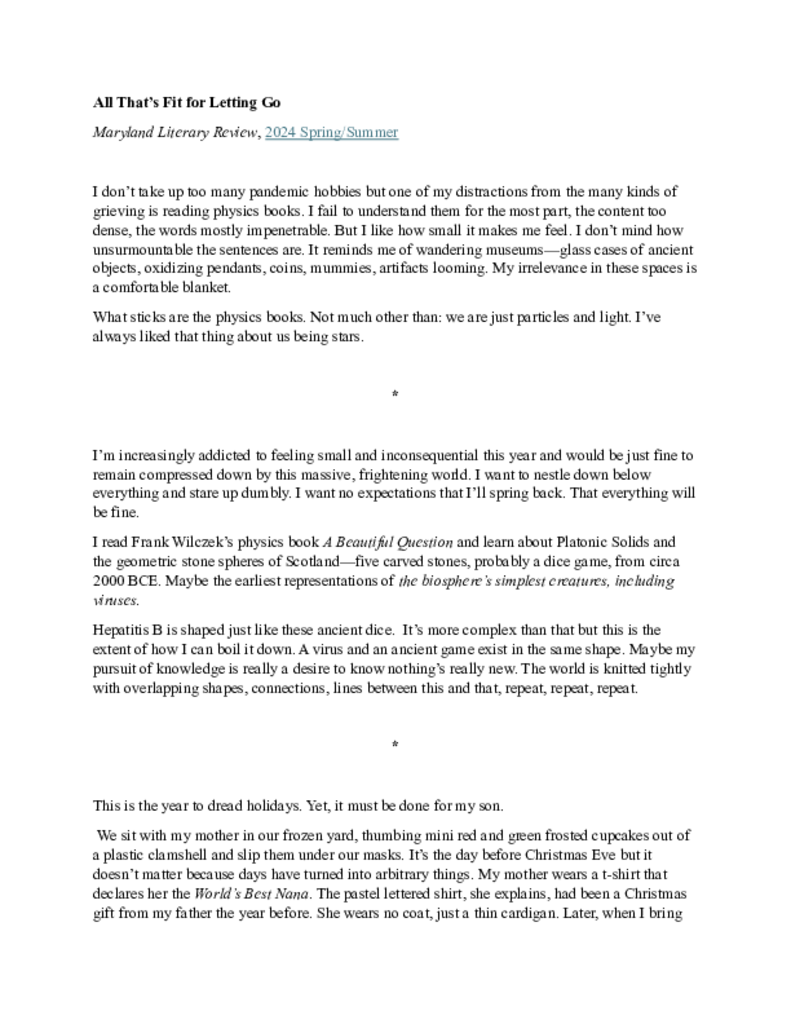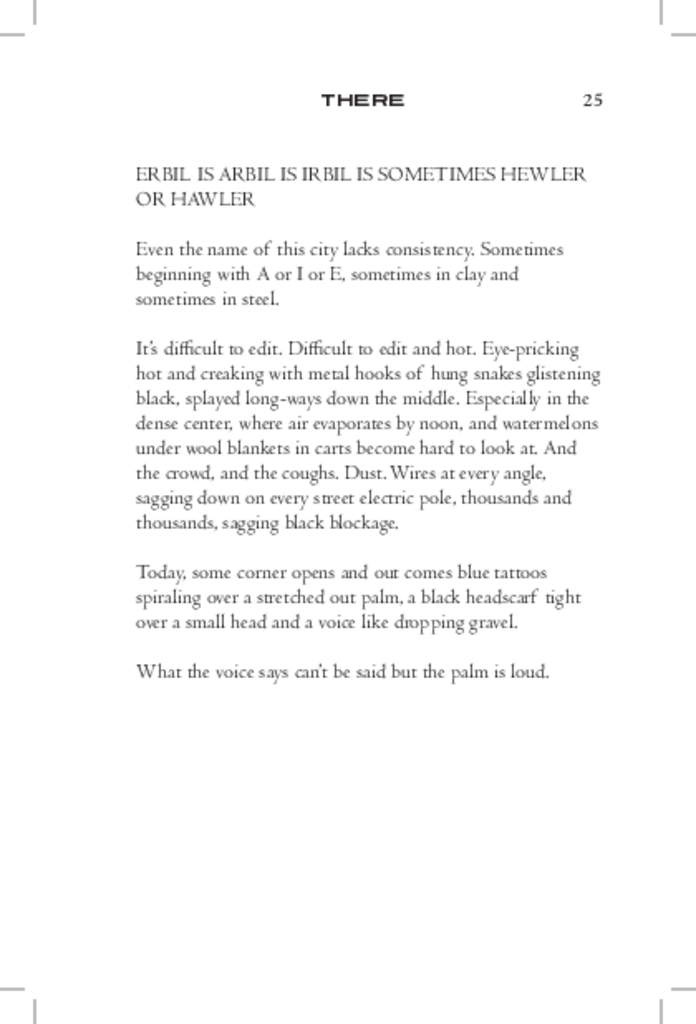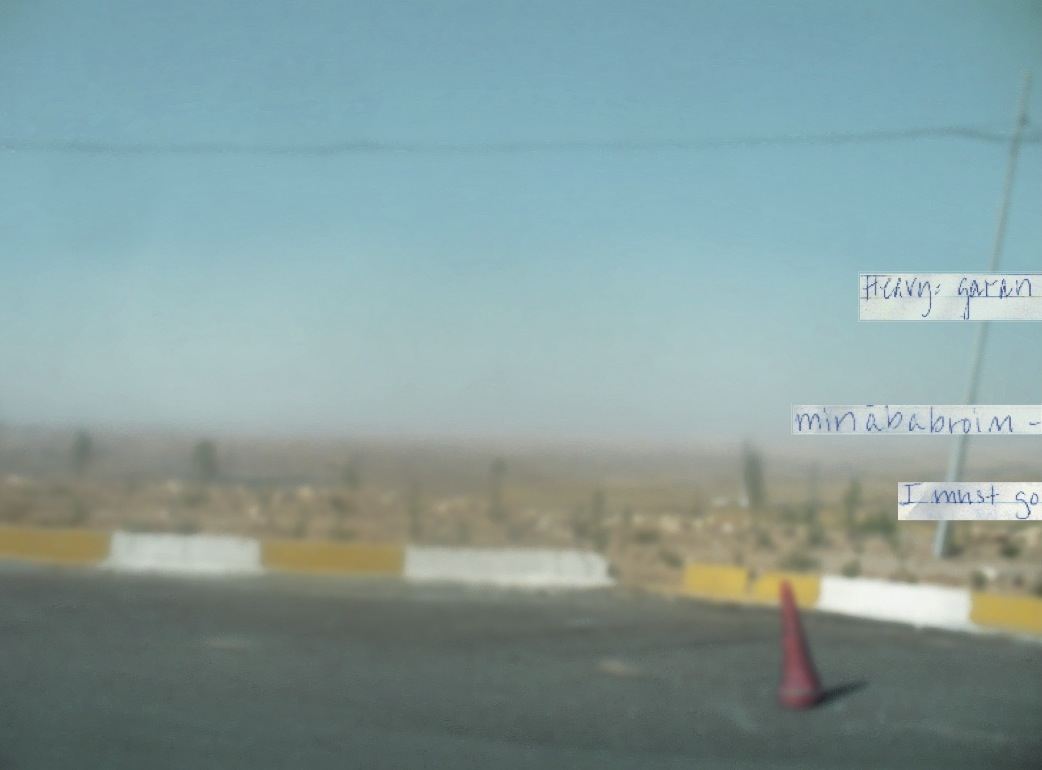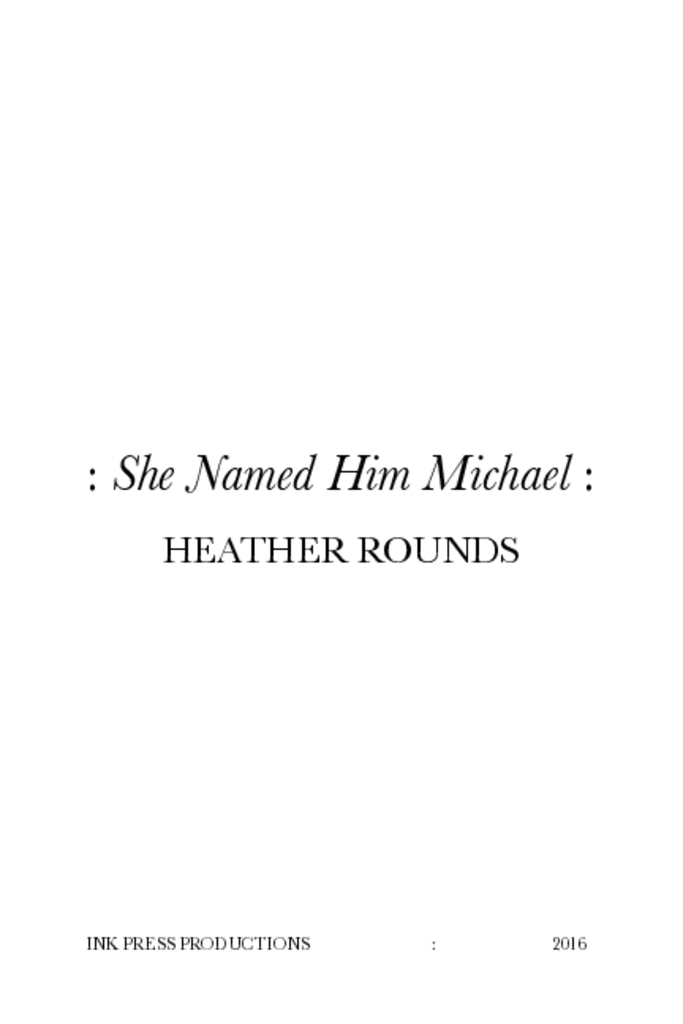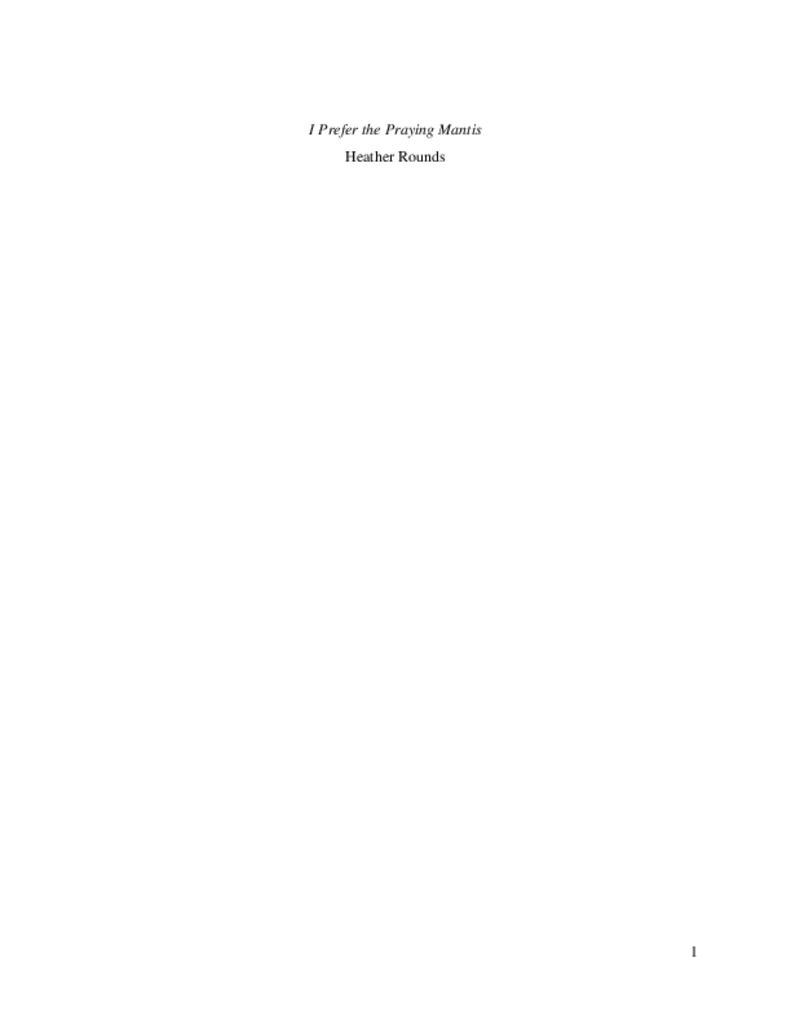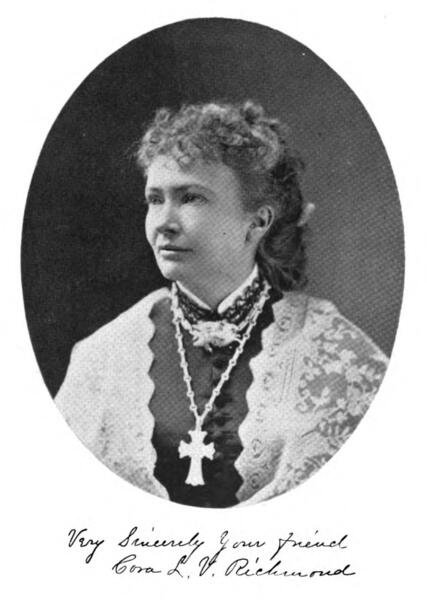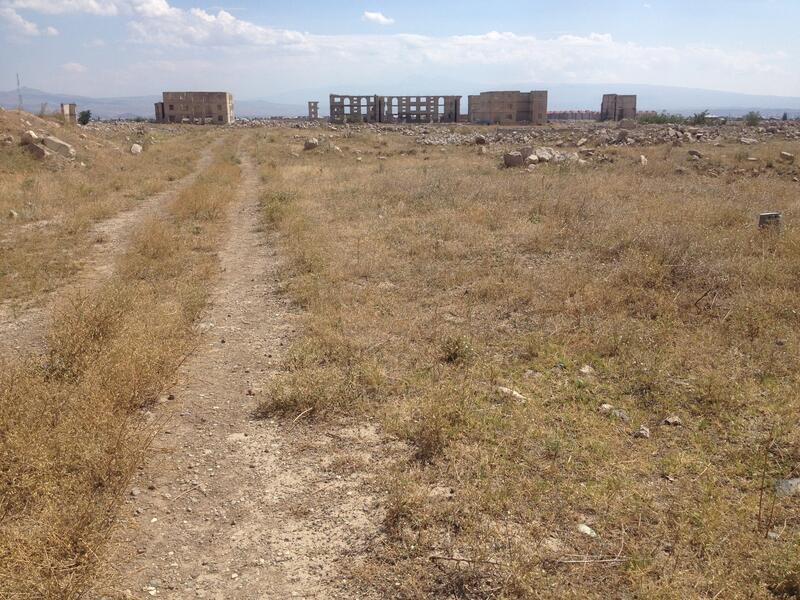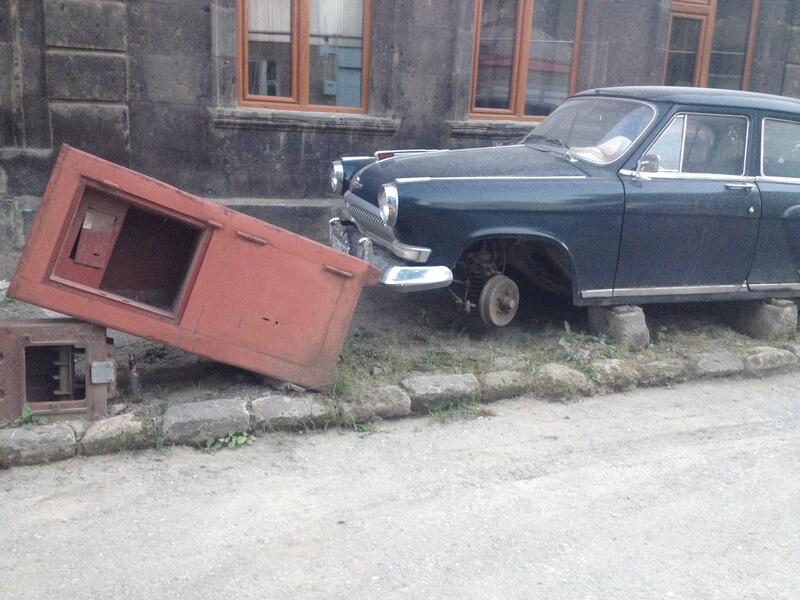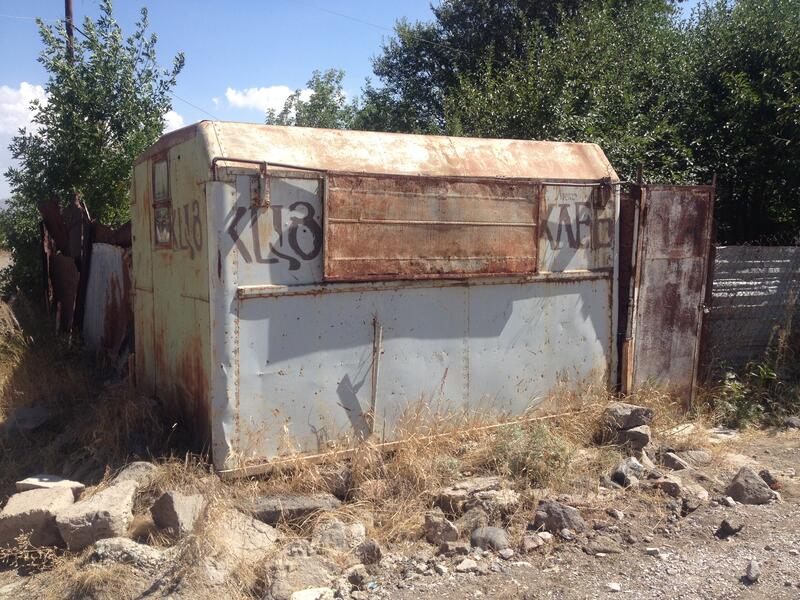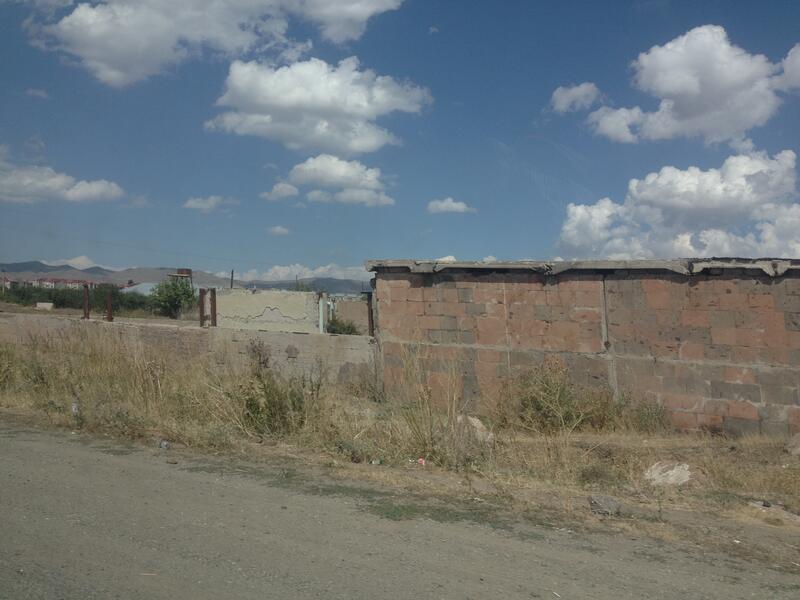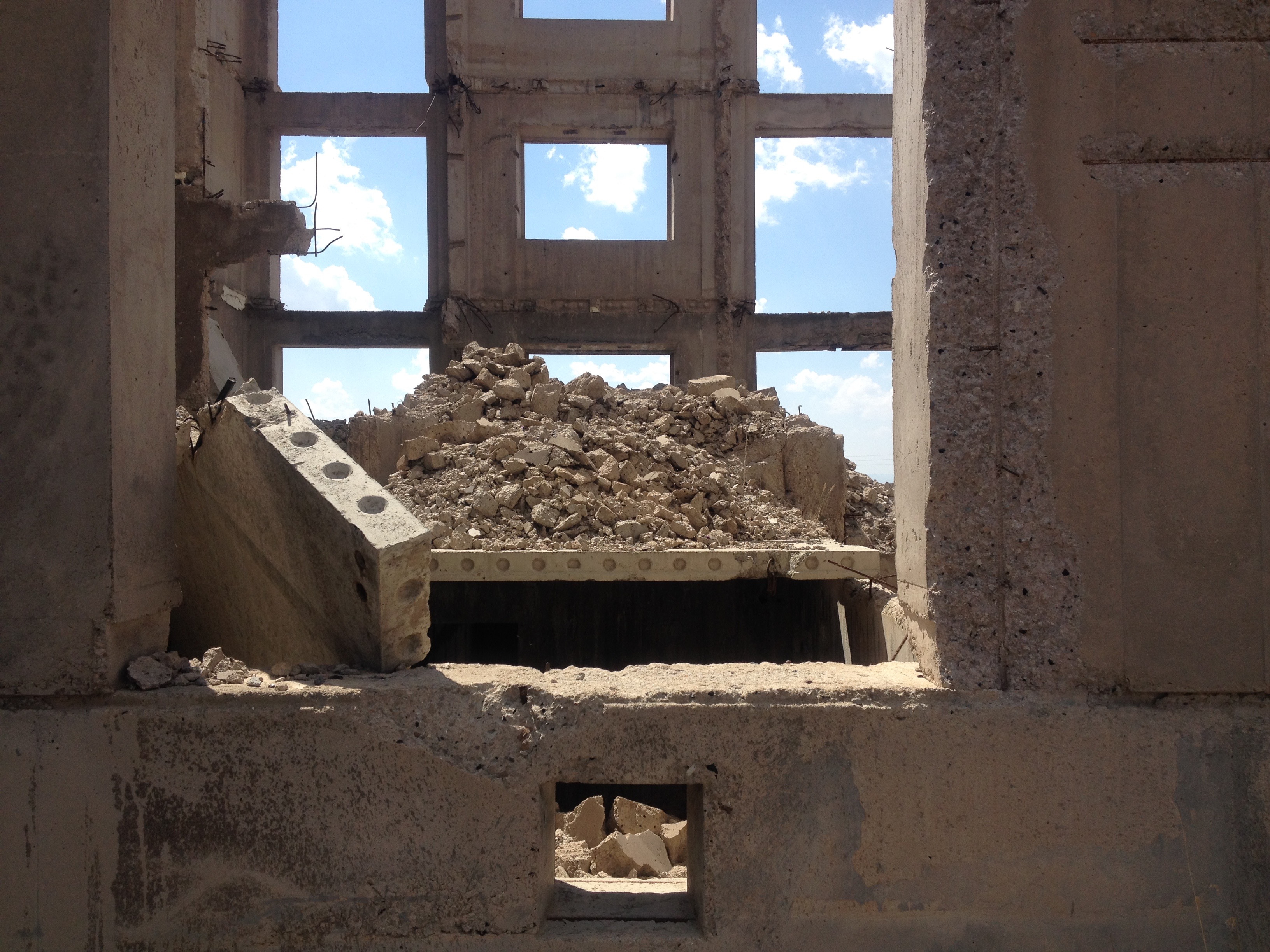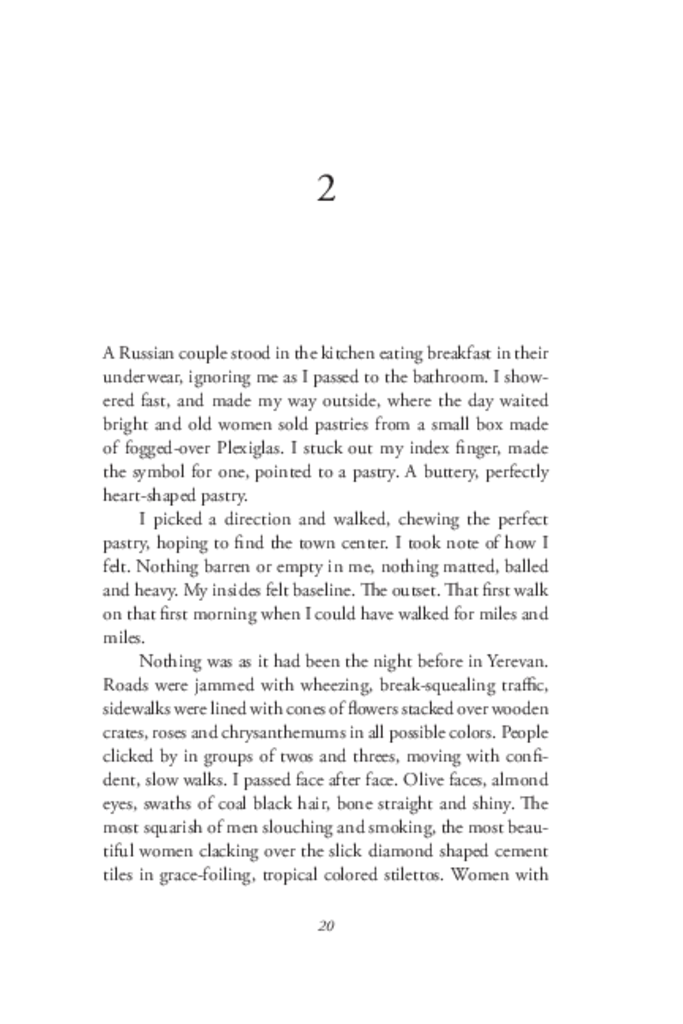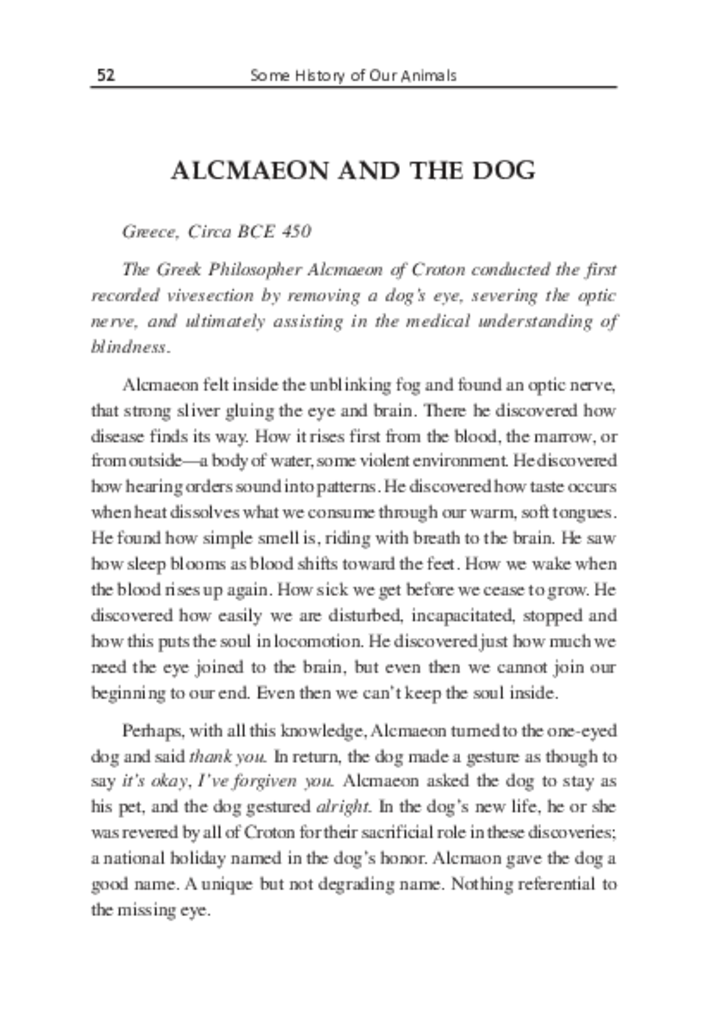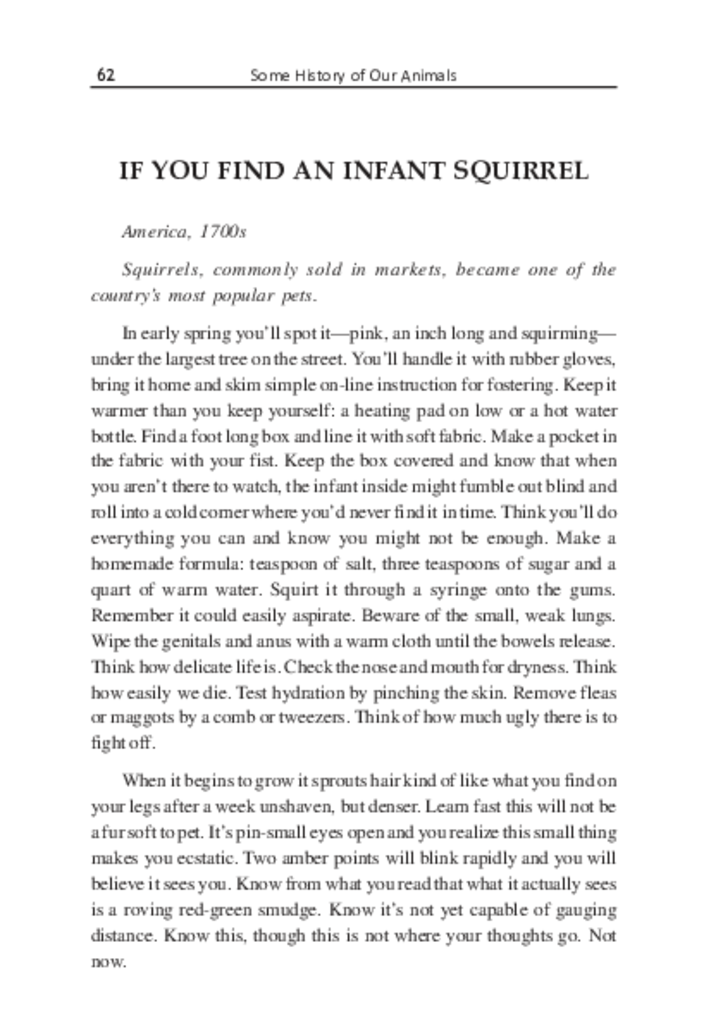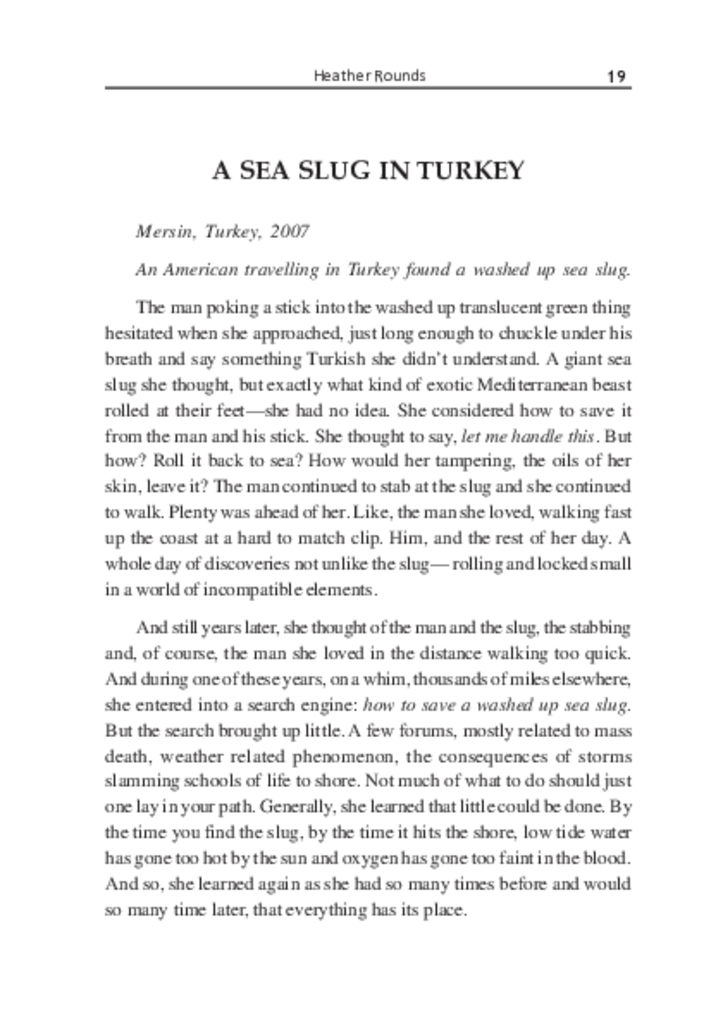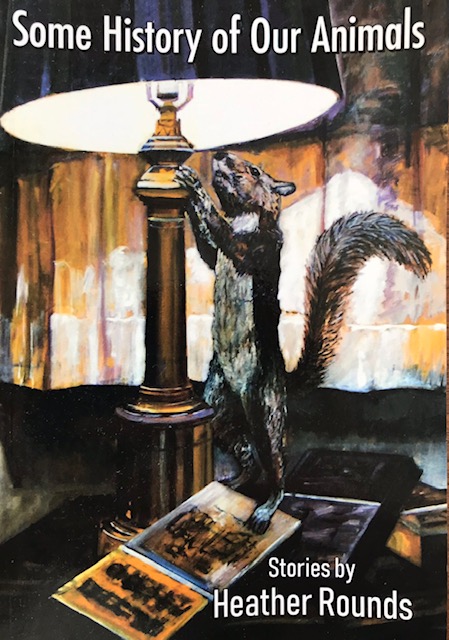Work samples
-
I Prefer the Praying Mantis: an Essay
I Prefer the Praying Mantis was published in Bayou Magazine in 2023 and was a Pushcart Nominee. The essay is based on a hybrid memoir with the same title, that will be published by Galileo Press in 2026. The project examines the religion of Spiritualism, especially the lives of 19th century women involved in the early days of the American Spiritualist movement—and my mother’s own experimentation with the religion in 2002 and 2003. A religion based on the belief that the spirits of the dead communicate with the living through mediumship, the narrative of Spiritualism includes little-known feminist history, with women finding agency through careers as mediums, including in prominent positions aligned with presidents and political figures, while simultaneously pushed to the margins of society due to the controversial nature of their religious practices.
-
All That’s Fit for Letting Go: an Essay
All That's Fit for Letting Go was published in the Maryland Review in 2024. The essay is based on a longer hybrid memoir entitled I Prefer the Praying Mantis (forthcoming from Galileo Press in 2026). The project examines the religion of Spiritualism, especially the lives of 19th century women involved in the early days of the American Spiritualist movement—and my mother’s own experimentation with the religion in 2002 and 2003. A religion based on the belief that the spirits of the dead communicate with the living through mediumship, the narrative of Spiritualism includes little-known feminist history, with women finding agency through careers as mediums, including in prominent positions aligned with presidents and political figures, while simultaneously pushed to the margins of society due to the controversial nature of their religious practices.
-
The Wilderness Museum
The opening pages of a work in progress. The Wilderness Museum is hybrid work of prose that excavates the world of 19th-century neurology and hysteria. Inspired by the life and work of Jean-Martin Charcot at La Salpêtrière, this book-length project moves through the corridors of the infamous Parisian hospital where women—patients, performers, subjects—were staged as living exhibits of illness. Blending historical fact with imaginative reconstruction, the work interrogates the spectacle of suffering, the porous boundary between science and theater.
About Heather

Heather Rounds received her MFA in Creative Writing from the University of Baltimore in 2007. After graduating she took a teaching job in Kurdistan, Iraq and while there briefly did some journalism for a local, English-language newspaper. Her experiences with the paper served as the inspiration for her debut novel, There, which won Emergency Press’ 2011 International book award and was published by the Press in 2013. Though she started her publishing career as a poet, over the years… more
There: an experimental novel
After graduating with my MFA I took a teaching job in Kurdistan, Iraq and while there briefly did some journalism for a local, English speaking newspaper. My experiences with the paper served as the inspiration for my debut novel, There, which won Emergency Press’ 2011 International book award and was published by the Press in 2013.
This book gets to the bone of what I seek to most get out of the writing experience: An exploration of place, history and culture by way of the lyrical and visual, placing high value on the way words sound and look on the page, as well as the white space that surrounds them.
Synopsis: There follows a young American journalist working in the capital city of the northern Kurdish region of Iraq, a land verging on economic boom, but never far from a violent past. A cross-genre work that most closely resembles a novel, the story is at once driven and diverted by the young reporter’s struggles to negotiate her own uncertainties in a strange land— observing, participating, and retreating daily from the people and events surrounding her. Assigned reports that the newspaper bosses deem fit for an inexperienced female foreigner, she ultimately turns to writing her own story, relayed with careful attention to the intricacies of language rhythm, acoustics, and repletion. What she discovers is that her own in-betweenness is only amplified in this foreign place, that the tension between ancient customs and contemporary conflicts somehow provides a familiar backdrop for her own attempts to relate to the people back home who, confused by her choice to travel to a dangerous place, ask, why go there?”
Listen to an interview I did with Lisa Morgan on WYPR:
https://www.wypr.org/post/black-sabbath-drummer-bill-ward-heather-rounds-there-and-toy-piano-composer-david-smooke
Watch a reading I did at Yellow Sign Theater:
https://www.youtube.com/watch?v=ulE44eeKjRk
Read a couple reviews/interviews:
Guernica Magazine --
https://www.guernicamag.com/aditi-sriram-heather-rounds-is-over-there/
Bustle Magazine --
https://www.bustle.com/articles/6359-uprooting-breaking-and-releasing-in-heather-rounds-there
Some praise for There
“Rounds is a major new voice in Baltimore's literary scene, and There is a work of both beauty and courage.
Baynard Woods, Author of I Got a Monster: The Rise and Fall of America's Most Corrupt Police Squad
"As an American writing about time spent in the Middle East, Rounds’ voice is mercifully free of the hubris and self-pride that infects many Western travelers. This story has been skimmed of Orientalist attitudes and biases; this is a rare protagonist whose eyes have not been clouded with self-righteous assumptions and expectations."
Claire Luchette, Bustle
“Rounds has passed her life onto these characters, and them onto us. Putting There around our eyes, our ability to see a girl in clothes she does not recognize, hankering after the small, vital facts that tell her story.”
Aditi Sriram, Guernica
“Heather Rounds manages to make entirely everyone in her novel, There, rootless and adrift, whether that be her American protagonist or the various homelanders she meets on assignment in Kurdistan. No one—and certainly not the reader—escapes from a feeling of escape, of a gnawing tumble in space. Thing is, that feeling is so perfectly pitched, so well attuned through imagination and craft, that one feels the wheel of familiarity, a presence of home in homelessness.”
Joseph Young, author of Easter Rabbit
“Rounds gives us her eyes and ears, jacks us up with the heightened receptivity of the traveler, and sets us down in Iraqi Kurdistan. With direct, economical prose, alive to its surroundings, she chronicles every contour of that space between wanderlust and the way a place actually turns out to be—and the way one turns out to be in it. There takes us all the way in, and on the way gives us a meditation on the poetics of self as a foreign body, on the accidental poetry of translation and strangeness, on the merry-go-round of subtle breakthroughs, approaches, and evasions; in short, the being there, and the being always destined to lose it all by going home.”
Megan McShea, author of A Mountain City of Toad Splendor
-
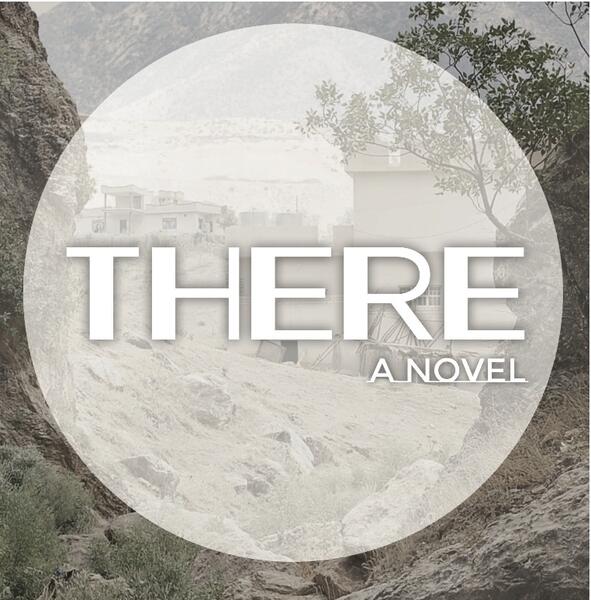 THERE COVER section.jpg
THERE COVER section.jpg -
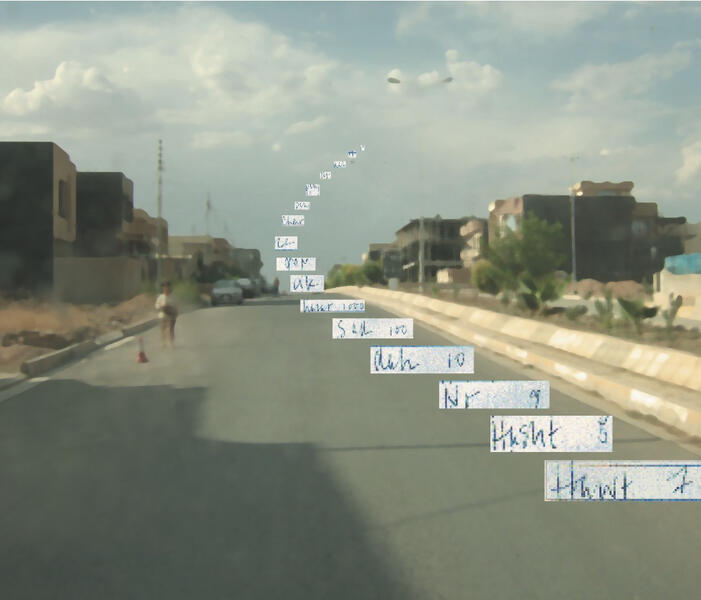 ROUNDS_image 1.jpgAn image I created to accompany a piece I wrote for Necessary Fiction's Research Notes Series. Research Notes invites authors to describe their research for a recent book, with “research” defined as broadly as they like. The image includes a manipulated photo I took in the town of Erbil, Kurdistan and pieces of handwritten notes I took while there. Read the piece and see all the images by visiting http://necessaryfiction.com/blog/ResearchNotesThere
ROUNDS_image 1.jpgAn image I created to accompany a piece I wrote for Necessary Fiction's Research Notes Series. Research Notes invites authors to describe their research for a recent book, with “research” defined as broadly as they like. The image includes a manipulated photo I took in the town of Erbil, Kurdistan and pieces of handwritten notes I took while there. Read the piece and see all the images by visiting http://necessaryfiction.com/blog/ResearchNotesThere -
 ROUNDS_image 3.jpgAn image I created to accompany a piece I wrote for Necessary Fiction's Research Notes Series. Research Notes invites authors to describe their research for a recent book, with “research” defined as broadly as they like. The image includes a manipulated photo I took in the town of Erbil, Kurdistan and pieces of handwritten notes I took while there. Read the piece and see all the images by visiting http://necessaryfiction.com/blog/ResearchNotesThere
ROUNDS_image 3.jpgAn image I created to accompany a piece I wrote for Necessary Fiction's Research Notes Series. Research Notes invites authors to describe their research for a recent book, with “research” defined as broadly as they like. The image includes a manipulated photo I took in the town of Erbil, Kurdistan and pieces of handwritten notes I took while there. Read the piece and see all the images by visiting http://necessaryfiction.com/blog/ResearchNotesThere
She Named Him Michael: an experimental novella
This is an experimental/cross-genre work of prose inspired by the true story of Miracle Mike the Headless Chicken—a Colorado chicken that managed to live for 18 months without a head. It’s a story about the fragility and resilience of nature and life, war, the grief associated with loss, how we might live with our dead and the unexpected ways in which one might choose to foster the life of another as a strategy for giving meaning to their own. The book was published by Ink Press in 2017 and won City Paper's Best Of for fiction that year.
The wonderful website Monkey Bicycle invited me to contribute to If My Book—a feature dedicated to authors comparing their recently released books to weird things.
This is what I said:
If She Named Him Michael were your eyes, those eyes wouldn’t get far down the night roads. Especially out of the city when met with the winding patterns or the fading broken white lines. No, it wouldn’t be age, those hapless eyes would have always been bad at night travels. No, it wouldn’t be their preference, those delicate retinas would pine to take it all in for as long as they were open to you.
If She Named Him Michael were your gallbladder it would have gotten carved out many ills and moons ago and you really wouldn’t recall that small, sludgy pouch now because, life.
If She Named Him Michael were your heart it would sometimes soar like a drone under the control of an unsupervised child. Just as susceptible to climbing over the winds as to a crash on some side street. Either way, easily broken.
If She Named Him Michael were your liver it would never forget to remind you of its vitality when it deemed it necessary. It would remain a quiet and passive gland only until you filled it up one too many times with the toxins you lean on and love and believe in so long as you can keep up the memory making.
If She Named Him Michael were your stomach it would be hard to believe that a pear shaped bit of you so deep down and hidden could sometimes feel so hollow, sometimes feel so full, sometimes feel so fired up, sometimes feel so unsure of itself and of you.
Read some reviews:
Baltimore City Paper—
https://www.baltimoresun.com/citypaper/bcp-051017-books-she-named-him-michael-20170509-story.html
Entropy Magazine—
https://entropymag.org/she-named-him-michael/
JMWW—
https://jmwwblog.wordpress.com/2017/05/17/review-she-named-him-michael-by-heather-rounds-reviewed-by-kristen-russell/
Watch the trailer:
https://www.youtube.com/watch?v=XcBGGd8eINM&t=1s
-
she named him michael.JPGOne of my favorite things about writing and publishing is the collaborations it affords. I was lucky enough to work with artist Teddy Johnson on the cover art and to be part of the overall aesthetic decisions related to producing this handmade book with Ink Press.
-
 FullSizeRender-4.jpgillustrations for She Named Him Michael by artist Teddy Johnson
FullSizeRender-4.jpgillustrations for She Named Him Michael by artist Teddy Johnson
I Prefer the Praying Mantis: Forthcoming hybrid memoir (Galileo Press)
In 2004 my mother forgot my birthday. To make up for it, she decided to invite me to join her and her congregation at the Light Center Spiritualist Church for a long weekend in Lily Dale, NY—an anchoring community of Spiritualist Mediums established in the 1870s. A religion based on the belief that the spirits of the dead communicate with the living through mediumship, my initiation to the religion came with my time in Lily Dale. It also gave me new insight into my mother, who I have never been very connected to. In 2004, my mother had begun attending the Light Center Spiritualist Church, which went against the grain of my father’s conservative values, serving to further disrupt our already dysfunctional family. But the religion for my mother, a formerly reclusive and secular individual, translated into a new sense of purpose. By 2005, though, she retreated from the Spiritualist community, for reasons she would never totally disclose to me.
While never a convert myself, I was curious about my mother’s Spiritualist quest, and the way in which it transformed her so abruptly. My trip to Lily Dale exposed me not only to the modern-day culture of Spiritualism, but the beginning days of the movement, too. I was especially drawn to the 19th century women who helped establish the Church and were integral to the American Spiritualist narrative. At Lily Dale I learned that the American Spiritualist movement includes little-known feminist history, with women finding agency through careers as mediums, including in prominent positions aligned with presidents and political figures. Despite their elevated positions in circles of authority, these Victorian women were simultaneously pushed to the margins of society due to the controversial nature of their practices. What’s more, I was fascinated by the newfound agency that my mother was able to have in her brief time as a practicing medium—and just as fascinated about why she might have so quickly left the Church.
In the early 2000s, I had hoped to write a book exploring these fascinations and experiences, but it never came to fruition likely because I just wasn’t developed enough as a writer or a person to pull it off. But I never abandoned the material—including research about the history of Lily Dale NY, and the founding women of American Spiritualism, as well as reflections on my exposure to the church, the changes the religion brought about for my mother and the disruption it caused in the family, primarily due to my father’s negative reactions to my mother’s pursuits.
After the pandemic began in 2020, I was forced to leave my full-time job to take care of my toddler. I was also dealing with the recent death of my father after a long battle with cancer. As an escape during the hellish year, I went back to my research and notes from my mother’s year in the Spiritualist church and began a new project that would eventually become this book.
Alicia Puglionesi, author of In Whose Ruins: Power, Passion, and the Landscapes of American Empire, had this to say about the book - A fugue-like meditation on how we (specifically women, specifically mothers) are defined by others and by forces that exceed us. The book grapples with the compromises of mediumship, the possibility of transmuting the given world, and the cruelty of possible worlds denied, all of which daughters are left to metabolize. Rounds gathers her voice from the absences and silences of a peripatetic childhood; she moves with compassion among those who find it easier to commune with the dead than with the living. Yet the profound assurance in these pages comes from the author's care for the materiality of actual lives and their limits: recognition, not consolation. Rounds gives us a place to stand, amid the restlessness of longing and loss, from which we can afford to seek mysteries rather than answers.
Light There is to Find: a novel
It’s fuzzy—I was young. But the earthquake that struck Gyumri, Armenia on December 7, 1988 was on my television. I remember it, that disaster that took out 80% of the city’s infrastructure and 25,000 lives. I remember it, even though it wasn’t my disaster and it wasn’t the disaster of anyone I knew. I remember it probably because it was the first time such an event made me think directly about how mean and unfair the world can be. I think that’s why I went there in 2015 and again in 2016.
And also, I think I went because I have a preoccupation, now more than ever, with these environmental disasters. The way they come to us through media and then disappear.
But they don’t disappear, right? We—the unscathed—we just move on to look at the next one. Most of us don’t see all the ways survivors survive.
I began in Gyumri with the intention of conducting all my research there, with the help of a wonderful fixer and a couple of equally wonderful translators. In Gyumri I learned that the disaster I saw on television back in 1988 was still very much there. Decades later and thousands of people still lack permanent housing. A lot of structures—houses, churches, hotels—remain as they fell. Doing research in Gyumri turned out to be really easy, in some regards. I met a lot of resilient and spirited people. They welcomed me and volunteered their sadness and traumas.
I had no idea what I would write—especially during my first trip. I thought, perhaps, a book of lyrical vignettes, transcribed oral histories, interview excerpts, informative data, lists, indexes, and photos. It didn’t end up like that at all.
During my second visit in 2016, despite all the beauty and spirit I found in Gyumri, I departed a little early. Perhaps because of personal things I was lugging along with me on my travels—the sadness, the intensity of the town, it kind of got to me. So I ended up in the Armenian capital, Yerevan, and from there ended up in the semi-autonomous region of Nagorno-Karabakh.
Shortly after the publication of my book, Light There is to Find, I held an exhibition and reading at the Microfiction Row House in Baltimore. The exhibition included photographs, video and interview transcriptions from my trips.
PRAISE FOR LIGHT THERE IS TO FIND: Light There Is to Find is a lovely, somber, funny book. Rounds is adept at avoiding the easy connections and instead mines real experiences and sorrow to explore how we wind up where we do and how we can progress beyond the confines of self-made prisons. - Michael Tager, author of Pop Culture Poetry: The Definitive Collection
Some History of Our Animals: short stories
Some History of Our Animals is a collection of short stories and works of flash fiction that explore the relationship between humans and animals. Published as a collection in 2020 by Cyberwit, several stories appeared previously in places like Smokelong Quarterly, Atticus Review and decomP Magazine.

